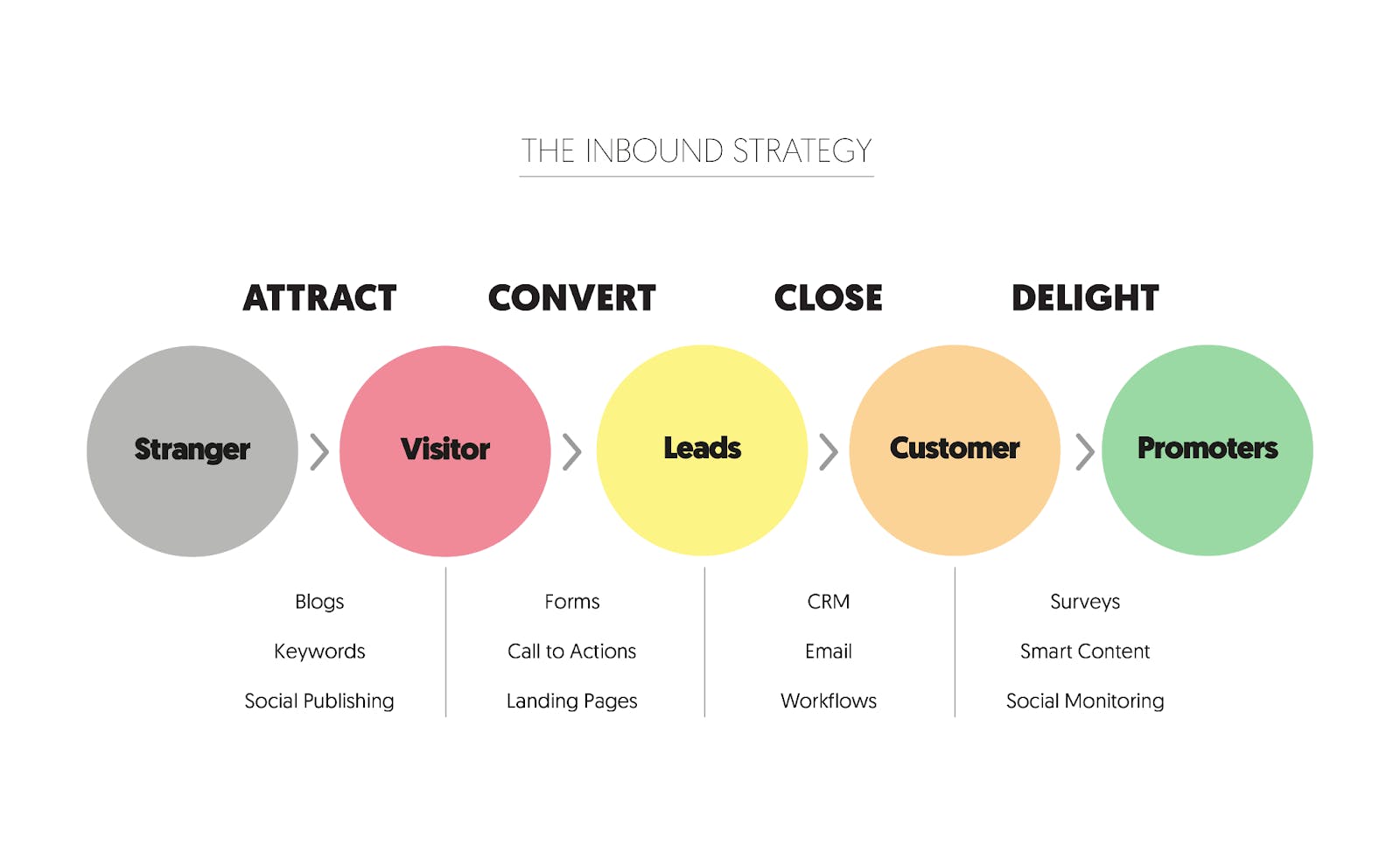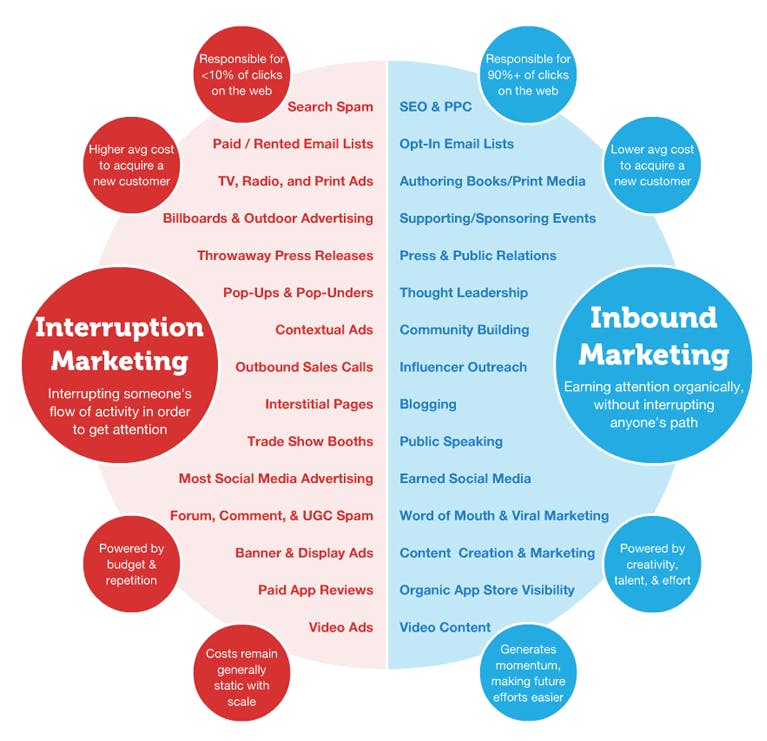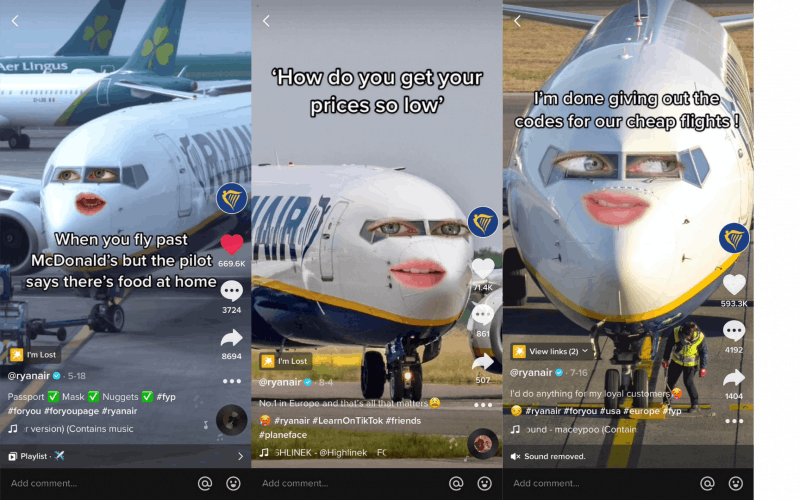Inbound marketing: definition, strategy and examples
Nov 14th, 2023

Contents
What is inbound marketing?
Inbound marketing strategy
Inbound marketing examples
How to get started with inbound marketing?
An effective inbound marketing strategy entails producing engaging content to keep visitors on your website. You should create compelling publications, podcasts, and videos across various platforms, which can be both promoted and naturally discovered through organic search, leading to increased traffic.
Inbound marketing is not solely focused on generating profits. It also revolves around helping people. It is a powerful strategy that enables companies to achieve great results combined with a more conventional approach like outbound marketing. In this article, we will explain the definition of inbound marketing, compare it to outbound marketing, discuss the overall strategy, and consider examples of outstanding inbound marketing in different industries.
What is inbound marketing?
Inbound marketing is a marketing strategy that prioritizes creating quality content to build long-lasting relationships with consumers. The key to inbound marketing is delivering valuable information about a brand and products rather than focusing primarily on sales. As a result, this customer-centric approach enables marketers to attract potential leads, increase visibility, improve conversion rates, and enhance overall marketing ROI.
The strategy typically encompasses a variety of tactics, including content creation, SEO, social media marketing, email marketing, and more. The goal is to guide potential customers through a personalized journey, from the awareness stage, where they discover the brand and its content, to the consideration and decision stages, where they evaluate products or services and make purchases. By providing helpful content throughout this journey, inbound marketing nurtures online leads into loyal customers, driving sustainable growth for businesses.

By generating useful content, you naturally establish trust and credibility, encouraging customers to choose your company when they decide to purchase. Furthermore, it's worth noting that inbound marketing not only proves to be more cost-efficient but also yields better results compared to traditional advertising. Remarkably, it costs $14 less per newly acquired customer than conventional marketing.
Moreover, unlike outbound marketing, which relies on interruptive tactics like advertisements and cold calls, inbound marketing seeks to naturally draw individuals in by providing information that addresses their specific needs and interests. Let us describe these two strategies in more detail and find the differences.
Inbound vs outbound marketing
Inbound marketing relies on using various types of content marketing like blog posts, videos, social media posts, and email newsletters that address the specific needs and interests of the target audience. It is designed to attract customers who are already interested in an offering.
Outbound marketing takes a more proactive approach by delivering marketing messages to a broader audience. It includes traditional advertising methods such as TV commercials, radio ads, cold calls, and direct mail. Outbound marketing often targets a wide range of people, including those who may not have expressed interest in the offering.
Inbound marketing has generally proven to be more cost-effective in the long run. While it may require an initial investment in content marketing and SEO, the results increase over time as the content continues to attract organic traffic. In contrast, outbound marketing can be expensive, especially for businesses that rely heavily on traditional advertising channels. It often involves significant upfront costs for ad placement and production.
With inbound marketing, companies can build meaningful relationships with customers. It establishes trust that can lead to consumer loyalty and repeat purchases. At the same time, outbound marketing aims to generate immediate leads and sales but may not build the same level of trust as inbound marketing. Customers acquired through outbound methods may make one-time purchases without developing strong connections with the brand.

Marketers can continuously optimize and improve inbound marketing strategy by tracking the performance of content and campaigns using analytics tools. Outbound marketing can take more work to measure accurately. While marketers can monitor the reach and response of outbound campaigns, it can be challenging to attribute specific results directly to these efforts. This lack of precision can make it more difficult to refine and adapt outbound strategies in real-time.
Inbound marketing strategy
Let us discuss how to devise a successful inbound marketing strategy and use an inbound marketing approach for your business.
Create a website or blog
The first crucial step in launching an effective inbound marketing strategy is to create a compelling website or blog. Your website functions as the central hub for all your inbound activities, acting as a virtual storefront that welcomes and engages your target audience.
Start by selecting a user-friendly content management system with customization options and plugins to enhance functionality. When designing your website, prioritize a responsive and visually appealing layout that caters to both desktop and mobile users. Ensure that your site is easy to navigate, with clear CTAs, and features high-quality, informative, and relevant content.
Incorporate best SEO practices into your website's structure and content to improve its visibility on search engines. This involves optimizing meta tags, using relevant keywords, and regularly publishing valuable content that addresses the interests of your target customers. Additionally, consider integrating lead generation forms and email subscription options to capture visitor information, enabling you to nurture relationships and guide them through the inbound marketing funnel.
Start a YouTube channel
Launching a YouTube channel is a pivotal step in building an effective inbound marketing strategy. Videos are a highly engaging form of content, and YouTube is one of the largest video-sharing platforms in the world. By creating and sharing valuable, informative, or entertaining videos on your channel, you can attract the attention of your target audience.
A YouTube channel allows you to build a loyal subscriber base, which can be nurtured and engaged over time. Moreover, you can use YouTube to generate leads by directing viewers to your website, landing pages, or other conversion-focused content. It can be achieved through compelling calls to action in your videos, encouraging viewers to take specific steps like downloading an ebook, signing up for a newsletter, or making a purchase. Optimize your efforts by reviewing YouTube Analytics data to find actionable insights.
This is a perfect platform for creating educational and informative content that addresses your target audience's pain points and questions. By providing solutions and practical insights, you position your brand as an authority within your industry. In addition, YouTube content can be repurposed across other marketing channels, such as your website, social media, and email campaigns.
Launch a podcast
Statista reports that 62% of US consumers listen to podcasts. Therefore, podcasts play a significant role in a modern marketing strategy. Launching a podcast will establish your company as a thought leader. As a result, your customers will perceive your business as a source of news, forecasts, trends, and fresh research.
In contrast to blog readers who may quickly scan a page for information, podcast listeners tend to be more actively engaged with the content. They establish a stronger connection with the host and are more susceptible to the speaker’s words. This engagement can lead to increased brand loyalty and a sense of community.
In addition, podcasts offer an opportunity to receive direct feedback from your audience through comments, reviews, and listener surveys. This feedback can help refine your content and better understand your audience's preferences and needs.
Leverage social media platforms
Social media networks like Facebook, Twitter, Instagram, and LinkedIn can be powerful inbound marketing channels. These platforms allow you to share content, communicate with your customers, and build a community around your brand. You can use social media to distribute blog posts, videos, infographics, customer testimonials, and other content that resonates with your target audience.
Consider sharing informative tips and instructional content related to your product. Remember that social media is a platform for conversations rather than one-way communication. Ask questions, respond to comments, and use hashtags to increase your reach. In addition, effective social media management involves creating a consistent posting schedule and encouraging user-generated content.
Conduct in-depth competitor research to learn what works well for your business. Create a visual identity and messaging that aligns with your brand. Post regularly and monitor the days when your publications receive the most engagement. It is helpful to view current social media best practices through the lens of the dark social approach - engaging your audience within their preferred platform and finding ways to build your presence and awareness without the need for them to visit your website.

Use email marketing
Email marketing remains a highly effective inbound marketing channel. You can use email to nurture leads, send personalized content, share product updates, and build relationships with your subscribers. Segmentation and automation tools enable you to tailor your emails to specific audience segments and their interests.
To launch an effective email marketing campaign, you should follow some recommendations. Once you have segmented your audience, create automated email sequences to nurture leads. Provide useful content, such as educational resources, tips, and product information, to guide leads through the buyer's journey. Tailor your messages to match each lead's stage in the funnel. Leverage personalization by addressing recipients by name and tailoring content to their preferences and behaviors. Personalized emails tend to perform better and feel more relevant to the recipient.
Include clear and compelling CTAs in your emails. Encourage readers to take specific actions, such as downloading a resource, purchasing, or signing up for a webinar. Use persuasive language and design to attract clicks. Ensure that your emails are mobile-responsive. Many people check their emails on smartphones, so messages must display correctly and be easy to navigate on smaller screens.
Host webinars and online workshops
Hosting webinars and online workshops can be an outstanding way to attract your target audience. These interactive sessions allow you to share expertise, educate your audience, and showcase your products or services. Webinars often require registration, which can serve as a lead-generation tool. After the event, you can repurpose the content as on-demand videos, blog posts, or downloadable resources, extending its reach and value.
Before creating a webinar, it's crucial to establish a definite objective, identify your target audience, and choose a captivating topic. Consider the specific issue you would address, the desired results you want to achieve, and the value you will provide to your participants. Research your audience's requirements, preferences, and challenges, and opt for a subject that aligns with their interests and needs. Then, create a compelling title, a summary, and a thorough outline for your webinar or online workshop.
The next step is to choose the right platform. The most popular platforms are Zoom, Microsoft Teams, and Google Meet. When choosing a platform, consider your budget, the number of participants, data security and privacy, quality of audio and video, and compatibility with additional tools and systems. Then, prepare a presentation and supplementary materials, such as worksheets, polls, and quizzes. Once you host an event, it's crucial to maintain contact with your participants to reinforce your message, gather feedback, and nurture relationships.
These channels, when used strategically, can complement your inbound marketing efforts by reaching and engaging your audience through various means and touchpoints.
Inbound marketing examples
Now, we will consider four examples of inbound marketing campaigns that worked well for companies in different industries.
Ryanair
Ryanair provides affordable flight options that appeal to a younger demographic seeking budget-friendly travel opportunities, such as Gen Z. The key to attracting this audience segment is prioritizing authenticity, honesty, and transparency instead of striving for absolute perfection. With this knowledge, the company has gained 2 million followers on TikTok since its launch in 2019.

Clever and humorous videos produced by Ryanair strike a chord with Gen Z because they lack the formality of traditional advertising. Instead of pretending to be something they are not, they embody the essence of authenticity. Understanding its target audience allows the company to build strong customer relationships and increase brand loyalty and sales.
Spotify
Spotify's well-known Wrapped marketing campaign employed inbound marketing to connect with customers. This campaign's objective was to highlight the music and podcast preferences of its users throughout the year. The strategy implies creating useful content for subscribers, encouraging them to share their customized preferences on various social media platforms while providing rewards as incentives for taking part in the campaign.
As a result, the campaign turned out to be a success and gained over 400,000 tweets in the first three days. Users were excited about the personalized playlists and thorough listening statistics, which resulted in higher engagement. In addition, the Wrapped campaign allowed Spotify to increase brand awareness and attract new subscribers to the platform.
Chewy
Chewy, a pet food retailer, utilizes an engaging strategy on Instagram by focusing on educating the audience. The brand uses different content formats, such as live Ask Me Anything sessions featuring veterinarians and short video tutorials. Moreover, Chewy demonstrates its products in action in Instagram videos.
In addition, the company combines branded image-based publications with animated content. This approach helps Chewy stand out from the competitors on the visually crowded platform. This diversity not only captures the attention of their audience but also reinforces their brand identity. Chewy's inbound marketing approach drives user engagement and highlights its commitment to serving the pet-loving community, ultimately leading to increased customer retention.
GoPro
GoPro’s marketing is highly focused on customer lifestyle. Their inbound marketing approach relies heavily on maintaining a substantial social media presence and leveraging user-generated content. The company encourages customers to share their adventures and experiences captured with GoPro cameras. As a result, users become brand advocates by showcasing the capabilities of the company’s products in real-life situations.
By developing a community of passionate customers, GoPro has not only saved costs on traditional advertising but has also created an ecosystem where their customers actively contribute to their brand narrative, driving organic growth.
These examples demonstrate that inbound marketing is a great approach for attracting new customers, improving conversions, and increasing sales. With this strategy, companies can connect with their target audience, build lasting relationships, and effectively convey their brand's value proposition.
How to get started with inbound marketing?
Implementing an inbound strategy may seem like a challenging task. For this reason, we will provide six steps to help you achieve your marketing goals.
- Assess your existing marketing assets and strategies. Examine your previous and current marketing initiatives. Set a budget taking into account the team's resources and the tools and platforms you use, such as website content management systems, hosting services, marketing automation software, and CRMs. Consider whether your website effectively nurtures prospects by providing them with information about potential solutions to their challenges.
- Create target personas. When you have a clear understanding of your target audience, you can create relevant content that solves their problems. Begin by defining the demographics of your target personas, including factors like age, job titles, educational backgrounds, and industry experiences. Then, conduct interviews with your audience to gain insights into their values, interests, and needs.
- Determine your marketing strategy and objectives. As you implement an inbound program, maintain a focus on two key strategies: firstly, establish and adhere to defined processes, which may include continuous content creation and growth-driven website design cycles. Secondly, leverage the appropriate marketing tools, such as marketing automation and analytics software, to support your efforts effectively.
- Optimize your website. Make sure your website is informative, intuitive, and easy to navigate. For a website to be effective, it should incorporate essential elements like a blog, forms, and calls-to-action, which are visual elements or buttons designed to engage visitors and prompt them to access more in-depth content. In addition, it is crucial to consider features such as thank-you pages and email templates, which play a critical role in nurturing individuals who have downloaded content.
- Create and share content. Develop a comprehensive editorial calendar for your copywriters that encompasses a wide range of engaging and valuable content tailored to the preferences of your most promising prospects, and then adhere to this schedule consistently. While some users stumble upon your blog through online searches, you can significantly enhance website traffic and content visibility by actively promoting it across various social media platforms.
- Measure and improve. Regularly assess the performance of your website and all your inbound marketing strategies, making necessary adjustments based on the insights gained. Establish KPIs and track your performance according to these metrics. Collect customer feedback to improve your marketing activities.
An inbound marketing expert, such as a content strategist, may help your team with creating and implementing the inbound marketing plan. And although developing your strategy may require some time and effort, the outcome is extremely rewarding as it yields results that turn into marketing qualified leads and customers for both your marketing and sales teams. This investment in strategy development not only drives short-term gains but also lays a foundation for sustained success and growth in the long run.
